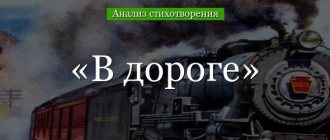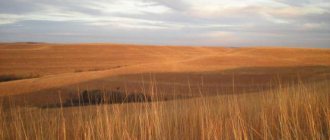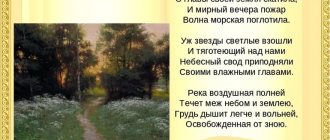4.2
Average rating: 4.2
Total ratings received: 114.
4.2
Average rating: 4.2
Total ratings received: 114.
“Peasant Children” is one of the works of N. A. Nekrasov, which can be called his calling card. In it, the poet describes the joys and difficulties of the life of peasant children. Behind the descriptions of everyday scenes, there is hidden excitement for the future of the little heroes, and the theme of the difficult fate of the Russian people emerges. Poem is studied in 5th grade. We invite you to familiarize yourself with a brief analysis of “Peasant Children” according to plan.
The material was prepared jointly with a teacher of the highest category, Ilyina Galina Sergeevna.
Experience as a teacher of Russian language and literature - 36 years.
Brief Analysis
Before reading this analysis, we recommend that you familiarize yourself with the poem Peasant Children.
History of creation - the work was created in July 1861, it was first published on the pages of the magazine “Time” in the same 1861.
The theme of the poem is the life of peasants and their children.
Composition - The analyzed poem is structured as a monologue-reasoning of the lyrical hero about the fate of peasant children. At the beginning of the poem, the author gives an introductory episode that allows us to understand what prompted the lyrical hero to think. The introduction is constructed in the form of a polylogue. The meaning of the work is divided into several parts. The monologue of the lyrical hero consists of stanzas with a different number of verses.
Genre : poem.
The poetic meter is amphibrachic tetrameter, cross rhyme ABAB.
Metaphors - “the rays of the sun are looking”, “the soul was touched by tenderness”, “I was making mushroom raids”, “the blues left my soul”, “those honest thoughts that have no will”, “the charm of childhood poetry”.
Epithets - “gray, brown, blue eyes”, “holy soul”, “thick, ancient elms”, “deafening bark”.
Comparisons - “mixed like flowers in a field,” “brown heads over a desert river, like porcini mushrooms in a forest clearing,” “and the legs are long, like poles.”
Analysis of the poem
The heroes of the work, even in difficult conditions of existence and the need to work from an early age, find the strength to play and support each other. They are confident that they can cope with any problems. Looking at them, the author experiences joyful emotions, but immediately thinks about the future of the children.
Without study and decent living conditions, life will be filled with thoughts of survival. To attend school, children need textbooks, pens, and clothes. The costs for them are unaffordable for ordinary people who work on the land from morning to evening. The question of whether they will be able to change something in their destiny remains unanswered. However, it is clear that a positive attitude towards life will help you cope with adversity more easily. A brief analysis of the poem “Peasant Children” should be carried out in the reader’s diary according to the following plan:
- Year of writing. The work was created and published in 1861.
- Subject. The unenviable fate of the ordinary Russian people.
- Composition. Monologue-reasoning of the lyrical hero about the fate of ordinary children. At the beginning there is an introduction from which readers understand what prompted the author to think.
- Genre. Poem.
- The main idea. The life of peasant children is full of worries and vivid impressions. Without education, a hard life awaits them.
- Poetic size. Amphibrach tetrameter with cross rhyme.
- Metaphors: “I made mushroom raids with them,” “the rays of the sun are looking cheerful.”
- Epithets: “thick, ancient elms”, “holy soul”.
- Comparisons. The author compares blue children's eyes with a field of flowers: “they mixed together like flowers in a field.” Another example in the work is “and the legs are long, like poles.”
- Hyperbola. “If they use a saw, they won’t sharpen it even in a day.”
History of creation
The history of the creation of the work is closely connected with the childhood of N. Nekrasov. Everyone knows that he grew up on the estate of his landowner father. The master's son was not ashamed to play with peasant children; on the contrary, he really liked such a cheerful company. Nikolai Alekseevich took part in all the fun of the children, which is why he described them so vividly in the poem.
As an adult, the poet loved to go hunting. At the beginning of July 1861, in Greshnevo, Yaroslavl province, Nikolai Alekseevich wrote “Peasant Children”. He worked on the piece for about two weeks. The portrait of the lyrical hero of the poem is autobiographical.
Subject
Written shortly after the liberation of the peasants from serfdom, the poem is dedicated to an important topic in the work of the poet-citizen - the fate of the Russian people.
This problem was common in the literature of his era. The main role in the poem is played by the collective image of children and the lyrical hero. Peasant childhood is presented from the point of view of the lyrical hero. He knows about all childish fun, even though he himself is a nobleman.
The poem begins with a short story from the lyrical hero that he has again come to the village, where he hunts and writes poetry. After the hunt, the hero fell asleep in the barn, and when he woke up, he noticed that children were looking into the cracks. Without giving any sign that he saw the guys, he listened to their whispers.
The children looked at the hunter with interest, noticing every detail of his appearance. It was funny to them that the hero had a beard, because they knew that “bares” wear mustaches. The children saw a watch on the hat and began to guess its price. Everything was a wonder for peasant children. They were afraid of the hero, apparently more than once they observed how the “bares” treated the peasants. After whispering a little, the guys hurried away because they noticed that the hunter had woken up.
After the polylogue, a monologue of the lyrical hero about peasant children is given. He admits that he envies their carefree childhood, free from science. He enjoys watching the children play and help the adults. Anything seems like fun to this audience. The lyrical hero recalls how he once played with the children of peasants. The nostalgic mood does not pacify him for long.
Soon the hero begins to consider “the other side of the coin.” He understands perfectly well that without science these children are doomed to hard work and a poor life. He confirms his thoughts with an incident from life. Once the lyrical hero met a six-year-old boy who was helping his father prepare firewood in the forest, because there were no other men in their family.
The poem ends optimistically. The lyrical hero shows the guys what his dog can do. The children watch these “things” with pleasure, but still don’t dare approach the master.
The main idea of the poem can be formulated as follows: the childhood of peasant children is happy, full of bright impressions, but without science they will face a sad fate in the future.
Analysis of the poem “Peasant Children” by Nikolai Nekrasov
As a child, the writer Nikolai Nekrasov himself lived surrounded by peasant children. Nikolai grew up on his father’s estate and felt well the charm of real village life in the wild, which was so different from city life. As a child, the boy Nikolai did not consider himself the master’s child, so he treated his peasant friends as equals. When Nekrasov grew up, he loved to visit the village and watched with pleasure the peasant children. The poet expressed his thoughts in the poem “Peasant Children”. The year the poem was written is 1861.
We will draw up a detailed plan and descriptions of the poem, title each part
The poet Nikolai Nekrasov talks about his hunt in the village. He went into an old barn to rest and accidentally noticed peasant children who hid and watched the master. The poet secretly eavesdrops on the children's conversation. In this conversation, the writer discovered a whole mysterious world that exists only in the mind of a child. These children already understood their difference from the master, but had not yet realized in this their real position, humility and humiliation. For peasant children, a master is a mysterious creature who has his own special life and way of life. The master is surrounded by special mysterious objects, which, of course, are not in their village.
Nikolai Nekrasov is touched by these naive conversations and views. The writer thought about peasant children, about their lives and children's views. The writer understands that for high society these children are inferior creatures with whom one can only fill an army of obedient soldiers and servants. The poet Nekrasov recalled vivid incidents from his life that the writer had surrounded by peasant children.
Peasant children are no different, and even make a more favorable impression compared to barchuks. Both peasant children and barchats are equal to each other. All children have a rich inner world. And village life is a source of rich, vivid impressions, real life.
Peasant children live in nature and play in the fresh air. Children can perceive any event as an adventure. For example, picking mushrooms and berries.
Peasant children begin to work hard from early childhood. For some kids, work is fun. Elders and children more seriously understand that their whole life will be spent in such “games and undertakings.”
The well-known passage “Once upon a time, in the cold winter ...” from this poem shows us the difficult life of peasant children. At a time when a six-year-old nobleman is forbidden to even go outside in the cold, a village child himself drives a horse and prepares firewood, taking care of his family.
The poet of the poem Nekrasov admires peasant children. He sees in such children not uneducated people, but, on the contrary, an expression of the national healthy spirit. Therefore, the poet encourages poor children to enjoy a completely carefree childhood, the countryside, nature, and mushroom picking.
However, at the end of the poem “Peasant Children” Nekrasov returns us to reality. He made the children laugh with the habits of his dog, and then went hunting. This neutral episode emphasizes that the author cannot change the plight of serf children. Childhood will pass quickly, happiness too, and a whole harsh work life lies ahead.
Composition
The composition of the work is original. It is constructed in the form of a monologue-reasoning of the lyrical hero about the fate of peasant children. At the beginning of the poem, the author gives an introductory episode that allows us to understand what prompted the lyrical hero to think. The introduction is written in the form of a polylogue. In terms of meaning, the work is divided into several parts: a story about how children watch a sleeping master, a reflection on the positive aspects of the fate of peasants, a reflection on its negative manifestations, and the ending. The monologue of the lyrical hero is divided into stanzas with different numbers of verses.
Means of expression
To reveal the theme and realize the idea of the work, the author used means of expression. Metaphors predominate in the text : “the rays of the sun are looking”, “tenderness touched the soul”, “I was making mushroom raids”, “the blues left my soul”, “those honest thoughts that have no will”, “the charm of childhood poetry”. The pictures are supplemented with epithets - “wonderful sounds”, “sleepy melancholy”, “zealous reader”, “wild critic”, satires “ignoble and offensive”, “thick, ancient elms”, comparisons - “mixed like flowers in a field”, “ brown heads above a desert river, like porcini mushrooms in a forest clearing,” “and the legs are long, as if like poles.”
Analysis of Nekrasov’s poem “Peasant Children”, essay
Analysis of the poem “Peasant Children”
The poem “Peasant Children” by N. A. Nekrasov was first published in 1861 in the magazine “Time”. In its general mood, it is very similar to the writer’s later poem “Frost, Red Nose” (1863). This is a warm idyll, which reflects the author’s tenderness for the children of peasants and concern for their fate.
The poem is written in amphibrachic tetrameter, cross rhyme with deviations in some fragments. Based on the nature of the stress on the last syllables, the author uses alternating feminine and masculine rhymes.
The ring composition of the poem is interesting. In the first part, the lyrical hero talks about meeting the guys on a hunt. Then he moves on to his memories, alternating them with reflections on the fate and upbringing of peasant children. In conclusion, the hero says that “Now it’s time to return to the beginning,” and we are again transported to the hunting situation. It ends with an open ending - this is a characteristic technique for Nekrasov. The heroes waited out the storm and went on a new hunt, but this event is already out of our sight.
The features of the composition do not allow us to call the time and space of the poem linear. First we are in a hunting situation, then we are transported into the space of the hero’s thoughts, from which he takes us to the space and time of his childhood. Critics attribute the work to autobiography - the lyrical hero may well describe the memories of Nekrasov himself, who was brought up on a family estate in the village of Greshnevo.
Reflections on peasant children and their fate lead the poet to the key theme for him of the fate of the Russian people. Love is mixed with a feeling of pain (contrasting the epithets “red childhood” and “scarce field”, mentioning “honest thoughts that have no will”). Nekrasov’s poem fits harmoniously into his work and contains discussions on topics relevant to that time.
After studying the analysis of the poem “Peasant Children” about





